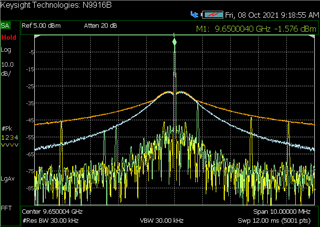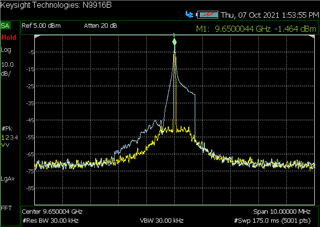Hello,
I want to use the LMX2492 in ramping mode (I have a LMX2492EVM board). When I tried to measure the phase noise in CW at the lower ramp limit frequency, it turned out that the part generates high level of wandering spurs, higher than when ramping is enabled. Please see the attached LMX2492EVM spectrum measurement results.

The orange trace is for CW, the blue one for ramping enabled. Peak detector, long sweep.
Part configuration in TICS Pro after powering on:
Default Mode 2016-6-17, denominator changed to 16777216, frequency set to 9650 MHz - for CW
For ramping mode, in addition a ramp consisting of a single segment (from 9650 MHz to 9651 MHz, 100 us duration, RST enabled) was enabled.
Below the wandering spurs measured for 9850 MHz CW (Default Mode 2016-6-17, denominator changed to 16777216, frequency set to 9850 MHz):

Blue trace - max hold, yellow trace - single fast sweep, peak detector.
I'm wondering why the spurs are so high and how can I actually measure the phase noise of CW with the same settings as used with ramping enabled (in order to optimize the loop filter).
Kind regards,
Szczepan









